Washing machine belt: selection tips + replacement instructions
Everyday life has long been unthinkable without technological progress, which significantly simplifies life.One of such devices is a modern washing machine. The unit has a complex design and even the smallest parts play an important role.
For example, if a washing machine belt malfunctions, it can simply stop the entire washing procedure. Replacing it is not difficult if you choose it correctly. We will tell you how to find the right model for restoring a belt drive, and explain how to restore the functionality of your washing equipment.
The content of the article:
Specifics of belt drive
All components in a washing machine are interconnected and if any element fails, the washing process will be disrupted or completely stopped.
Belt drive is the connecting link between the engine and the pulley. It is the coordinated work of this unit that reproduces the movements of the drum when performing a given washing mode. If the component mechanism falls off or breaks, the device ceases to fulfill its purpose.
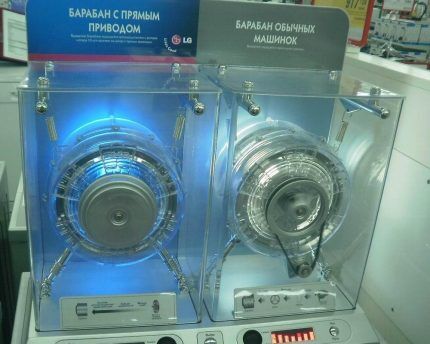
After loading the cylindrical drum and setting the required washing program, the process is as follows:
- The rear part of the drum, equipped with a friction pulley (visually a metal wheel), with a recess along the entire circumference, is activated by the friction forces arising from the tension of the elastic belt.
- A pulley is also attached to the electric motor, but of a smaller diameter. A system of two rings is connected by a drive belt, the main purpose of which is to transmit torque from the motor to the drum.
- In the process of reproducing engine torque, a speed of 5000-10,000 rpm is achieved. This indicator is quite large and therefore subject to reduction.
- To reduce the speed, a light, large-diameter ring is used, which is rigidly attached to the drum shaft.
- Due to this rotational transition from a smaller to a larger wheel, a weakening occurs to 1000-1200 rpm.
The belt tension coefficient has a significant influence on the effective transmission of forces. Excessive tension force promotes maximum transmission of torque.
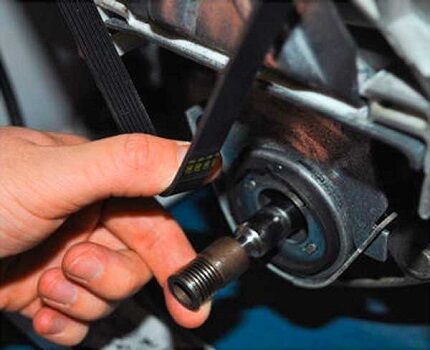
However, this significantly accelerates wear not only on the belts themselves, but also on the pulleys, bearings, seals and axles with which they come into contact.
If the situation is the opposite and the tension is weak, the belt will slip on the pulleys. The frictional interaction of surfaces entails polishing of the moving parts involved. The consequence of this process is a significant deterioration in adhesion.
Only thanks to the high elasticity of the flexible drive are both processes compensated, and electric motor functions in the right conditions.However, for this you need to correctly select the required model of the rubber part.
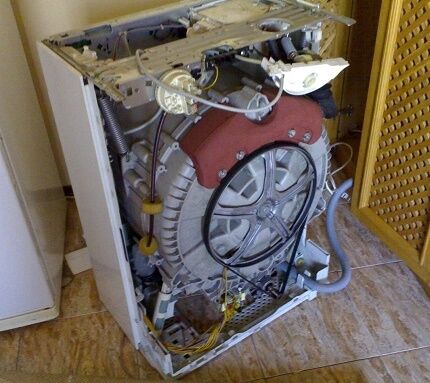
Correct selection of belt
The main task when choosing a belt drive is to find the part marking, for example, 1046 H7, 1100 J4, etc. Essentially, these are four digital characters and a Latin letter with a number. Accordingly, similar designations should be on the new part.
Differences between drive units
Externally, these structural elements differ not only in color, but also in the characteristics of the tread, length, number of wedges, as well as the materials used in the production process.
There are only two main types of belt drives, but there are differences between the cross-section profiles:
- monocline for foreign-made washing machines have a cross-section of 3 L, domestic - Z and A;
- poly-wedge (toothed) for large equipment - J, for small equipment - H.
Visually, they can be distinguished by the depth of the streams. As a rule, this kind of part allows the greatest power to be transmitted, because it has a better coefficient of adhesion. The maximum transmitted power reaches 100 kW.
The number of streams in the toothed edge of the drive can vary from 3 to 8, tracks - from 3 to 9 pieces. The distance between the strips in the J-shaped profile is 2.34 mm, in the H-shaped one – 1.6 mm.
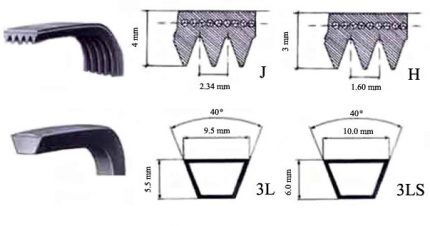
Outboard engine belts are also classified depending on the type of rigidity - elastic and rigid. The former are an ideal option for new models of washing units, as they have stretching properties.
These characteristics make it possible to achieve a rigid coupling between the engine and the tank. However, they do not have the ability to adjust the degree of tension.
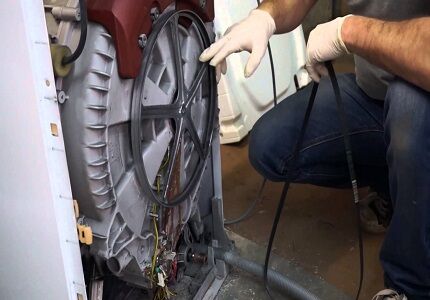
Rigid belts, on the contrary, have practically no stretch. Before installing them, you will need to adjust the position of the motor relative to the tank. This variation is rare and can only be found on old models of equipment.
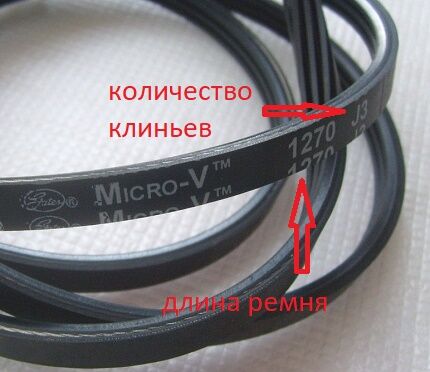
The length parameter is also of significant importance when choosing a part. In the marking, this indicator is indicated by numbers in front of the section profile and the number of wedges.
In addition to the distinctive characteristics described above, drive belts are made of rubber or polyurethane. The first variation has a greater degree of strength, however, this affects the low stretch coefficient in comparison with the polyurethane sample.
The second option is easy to install, but its wear rate is faster than that of a durable rubber product. The type of belt drive required is usually indicated by the brand of the automatic washing machine, since the motor pin is tailored specifically to its profile.

What to look for when choosing a replacement?
It is not always possible to read the belt markings; for example, with prolonged use, the coding can simply be erased. In such a situation, to select the necessary accessories, pay attention to the main parameters, which are discussed below.
First of all, the length of the connecting element is taken into account. If the choice is made incorrectly and the purchased belt is shorter or, conversely, longer than the previous one, it will either break or constantly fly off during operation. In this case, it is unlikely that you will be able to fully operate the equipment.
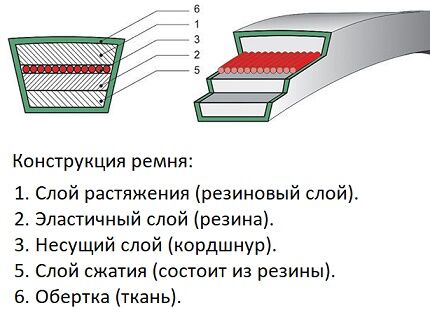
The cross-section profile must also be taken into account - an H-shaped one will not fit on a motor tailored for a J-shaped one. But the number of wedges does not need to be taken into account.
For example, belts with similar markings 1130 N6 And 1130 N7, 1276 J4 And 1276J5 almost identical. A product with more wedges will be wider. This reduces the likelihood of slipping.
All models of Samsung washing machines use belts with the same profile and length - 1270J. For narrow equipment, three-wedge parts with the code are used 1270J3, for medium and wide – 1270J5.
Determining signs of failure
If the drive belt has become unusable, the owner of the equipment will soon be able to notice it. However, it is quite difficult to determine that the problem is in the transmission unit, since the drive accessories are located in the equipment body.However, you can find out the true cause by characteristic signs.
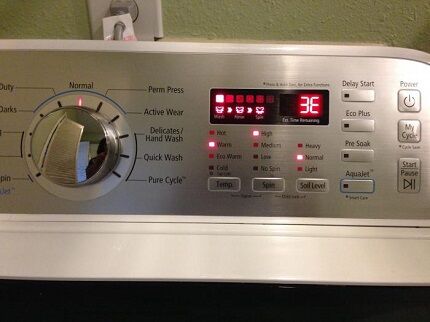
In most cases, the equipment independently determines the nature of the breakdown and notifies the user through the display or by highlighting the corresponding buttons. Depending on the manufacturer and modification of the device, the instructions will indicate a decoding of the error code.
If for some reason the unit does not break down, a flying off, torn or stretched part affects the operation of the washing unit in the following way:
- After selecting the washing mode, the program starts, the time is counting down, the motor is running, but the loading tank does not make any rotational movements.
- Equal time intervals between the audible hum of the engine and its complete stop.
- The selected washing mode is launched, the engine runs continuously, then the system is completely inactive without the possibility of ending the process early by pressing the program cancel keys.
- Manual rotation of the drum is carried out without hindrance.
All of the above signs indicate the need disassembling the machine and replacing the belt drive. To avoid a recurrence of this kind of trouble, it is worth considering in detail the reasons contributing to the malfunction, especially if it occurs regularly.

Main causes of malfunction
If the connecting link between the motor and the drum comes off for the first time, this is not always the cause of serious damage. This can happen if there is too much laundry. At the same time, installing the belt back is not difficult.
However, if this is not the first time the transmission has slipped, the damage may be more significant. Let's look at all the faults and methods for eliminating them in more detail.
Regular tank overload
Often the main reason for the rapid wear of the transfer unit is frequent overload with laundry. A washing machine with a tub designed to hold a 7kg load is not designed to handle the maximum possible load on a regular basis. During this washing mode, the load on the belt increases.

If the owner of the equipment loads the drum 25-30% less than the nominal weight specified in the instructions, then the service life of not only individual parts, but also the entire unit will be significantly longer.
With the elimination of disruptions in work, the consequence of which is non-spinning drum, will introduce you to an article devoted to an analysis of the causes and methods of restoring performance.
Unreliable fastening/breakage of the drum pulley
In simple terms, a washing machine pulley is a round cast-iron wheel with spokes located behind the drum. This is where the belt is put on. The entire mechanism is quite primitive, but reliable and effectively performs its functions until it breaks down.
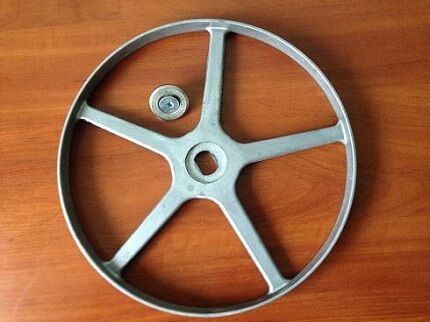
Since the washing process is carried out by means of a motor that transmits revolutions through a belt to a pulley, it is the transmission unit that is the weak link of the mechanism.
However, frequent slipping of the belt may be due to a malfunction of the rotating wheel. During the washing/spin process, you may notice a slow rotation of the drum.
You can check the condition of the wheel without dismantling it; to do this, you must perform the following steps:
- It is necessary to remove the back wall of the case.
- Now remove the belt: you need to grab it with your left hand, directing the effort towards yourself, and spin the wheel with your right, the drive will slide off on its own.
- With both hands, grasp the sides of the pulley and lightly rock the part. This way you can check the quality of fixation.
- To eliminate the possibility of defects, run your hand over the surface and visually inspect for deformation.
If any defects are found during the inspection, the part will need to be replaced with a new one. If you leave everything as is, you may have to change the belt more often than once every couple of months.
To replace the drive, you will first need to remove the old one. However, this process is not the easiest - the mounting bolt on which the pulley is mounted is additionally treated with sealant, but more on that a little later.
At the beginning of the repair, you need to disconnect the device from the power supply, drainage system and water supply. Using a Phillips screwdriver, unscrew the screws securing the back wall.
Next, using the method described above, remove the belt drive.Taking a small wooden wedge, you need to clamp it in the wheel cross. This is necessary to immobilize the mechanism when unscrewing the bolts.
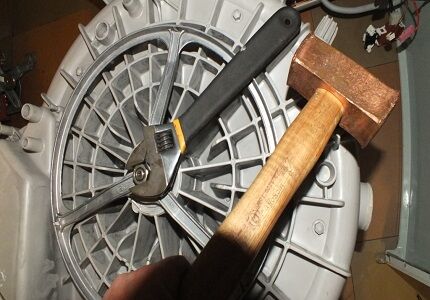
To unscrew the central bolt, you will need to heat it until red with a blowtorch. Then treat this fastener with a lubricant, for example, WD-40 or a similar technical aerosol. After a short period of time, put a wrench on the bolt and unscrew it, tapping it a little with a hammer.
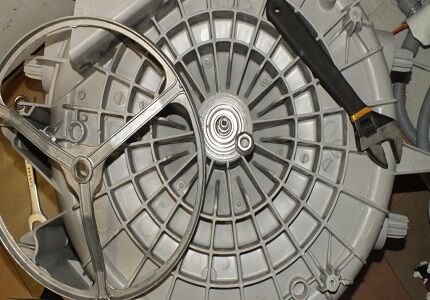
After completing the dismantling, if there are obvious defects in the wheel, it is replaced with a new part. To do this, the pulley is placed on the drum shaft, the screw is treated with sealant and screwed back in using a wrench.
Now we move on to the stage of replacing the belt. First, we put the belt on the engine, and then we pull it onto the large circle of the drum pulley, while turning it counterclockwise and gradually placing it in the provided grooves.
When finished, check the tightness of the fit by several turns of the wheel - its movement should be tight. After this, you need to return the back cover to its original place and secure it with bolts.
Bearing deformation and damage
There are cases when the cause of a flying belt is the misalignment of the drum due to failure or deformation of the bearings.

There are only two reasons for the failure of this part:
- The seals wear out, resulting in leaks and water entering the bearing. Thus, the part is covered with a corrosive coating.
- Long service life of the washing machine. Classic factor of temporary wear and tear.
The repair is quite complicated, but financially justified - the cost of a specialist’s services will cost 30-50% of the cost of a new unit.
First, remove the housing cover, attached with two screws to the back of the washing machine, and then the back wall. You also need to remove the detergent dispenser and control panel. Then, using a suitable tool, the front clamp of the hatch cuff is removed, and the restrictive part itself is removed from the body.

Now unscrew the door lock and remove all the parts along with the front panel. Then we disconnect the dosing hopper from the pipe coming from the drum. In the process, you will need to remove all obstructing parts, loosen the hose clamp and remove it.

To remove the tank counterweight, simply unscrew the mounting bolts with a screwdriver. In different models of washing machines, its location can be either on the front or the back.
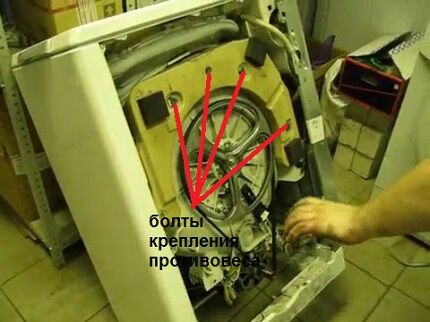
Having reached heating devices - heating elements, it is necessary to photograph the wiring for correct connection during reassembly.
Having unscrewed the fastener, we remove it from the cell by prying it with a screwdriver. The pipe connected to the tank and any possible wires are also disconnected.
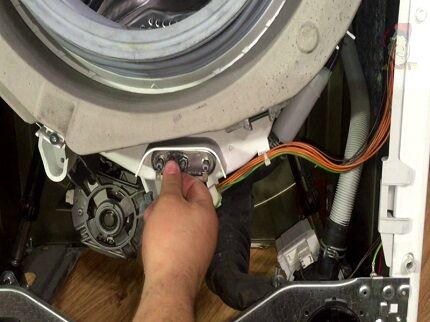
The next step is to remove the drive belt. All wiring to the motor must be disconnected. Next, twist the screws that secure the electric motor and remove it.
We deal with the shock absorber mounting screws in the same way. On the right and left of the tank there are springs that need to be removed. By disconnecting the hose tube from the tank, you can remove it.
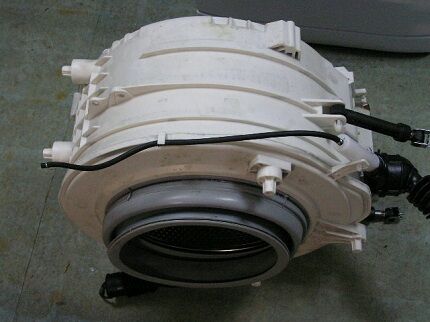
First of all, remove the cuff - this part must be replaced. However, you must first make notes at its location with a marker.
We remove the pulley - this process is described in detail in the previous section. After this, you need to try to sink the shaft inside the tank with your hands. If the attempt is unsuccessful, repeat using a rubber mallet. Now the tank is disassembled into two parts.
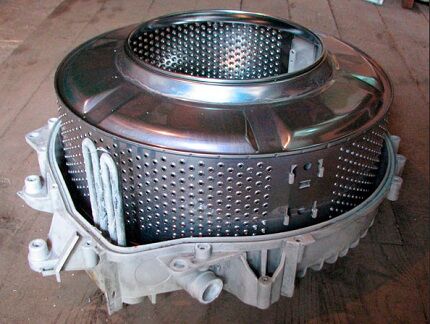
Having divided the tank and taken out the drum, the condition of the cross, bushing and shaft is carefully inspected. If the washing machine was used regularly after the bearings failed, these parts may also fail.
Using a hammer and chisel, knock out the bearings. However, the entire process must be carried out with extreme care so as not to deform the tank. There should be two parts that fall out - the oil seal and the bearing.
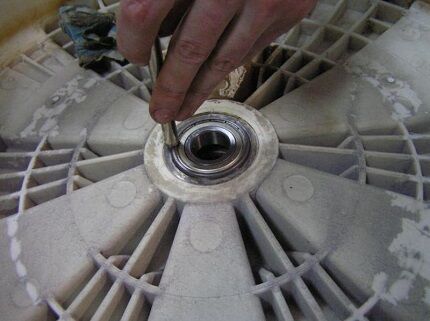
Place where it was installed washing machine bearing, are treated with a special compound, for example, universal lithium grease “Litol 24”. Instead of the worn part, we install a new bearing and hammer it in the same way.
At the final stage, we assemble the tank and the washing machine itself. In this case, the connecting seam on the tank and the gasket also need to be lubricated, only with a sealant with waterproof properties.
Conclusions and useful video on the topic
This video describes in detail the main parameters necessary for the correct selection of a belt drive for a washing machine, as well as possible reasons for the failure of this unit:
You can even replace the belt in the washing machine yourself. The video instructions will show you how to do this correctly:
The most difficult problem that contributes to the transmission belt falling off or breaking may be hidden in faulty bearings. Find out how to replace them from the story:
If the malfunction of the washing machine lies precisely in the link connecting the drum and the engine, it is necessary to take a responsible approach to choosing the appropriate marking of the part.
The process of replacing a belt drive is quite simple, but accompanying serious breakdowns can significantly complicate the process. Therefore, if the tank is disassembled, it is better to photograph all the parts for subsequent correct assembly of the torque mechanism.
Would you like to share your own experience in replacing a washing machine belt? Do you have valuable information on the topic of the article that is worth sharing with site visitors? Please write comments in the block form below, ask questions and publish thematic photos.




We have an Indesit machine, it’s old, but it works better than the new ones, but the belt has worn out and burst. I untwisted it myself, I wanted to see what the reason was, but everything was clear there right away. There was a marking on the belt, but over time it faded and is practically unreadable. I ordered it online, it looks similar. When I received it, it turned out to be not what I needed. The new belt is shorter than the previous one, exactly 1.5 centimeters. I tried to tighten it, but so far it’s not working, it’s tight, maybe there are some proven methods, who knows? Or throw it away and look for a new one?
Hmmm... In fact, such a big difference of 1.5 cm is not a buzz. Of course, you can try to tighten it, but it’s better to look for the same one as it was. The best way is to go to some service center where they repair washing machines and ask them. You can call a technician, tell the model of the washing machine and ask what belt you need. It will be more expensive, but certainly more reliable than buying something without knowing what.
I threw it into boiling water for 1-2 minutes and climbed in like a baby
And Egor, I would recommend that you keep the belt in hot water, it should stretch easier.You can also try moving the engine a little. But believe me, with such a big difference as yours (1.5 cm or more), you won’t be able to stretch it, buy a new one and throw away this one. Always look at the markings. She will tell you a lot. Better yet, take the old belt with you and buy exactly the same one.
Can anyone tell me which belt is suitable for the ATLANT 50u102 washing machine? Only J5 remains legible from the old marking.
If I understand you correctly, then you need a new belt for the Atlant 50u102 washing machine. The model is not new, plus there are different assemblies, so it is difficult to say which drive belt is suitable for it.
So, for example, belt 1173J5 PJE 908092003034 and 1165J5 EPJ 908092003035 differ by one number at the end, but these are two completely different belts. Although your model is on both lists, the year of manufacture and whose assembly is most likely also important. If possible, attach a photo of the belt. Or you can remove it and look for a suitable, identical one on the market.